Corn Rootworms (Corn)
Western Corn Rootworm, Diabrotica virgifera virgifera LeConte
Northern Corn Rootworm, Diabrotica barberi Smith & Lawrence
Southern Corn Rootworm, Diabrotica undecimpunctata howardi Barber
Search the Pest & Crop Newsletter
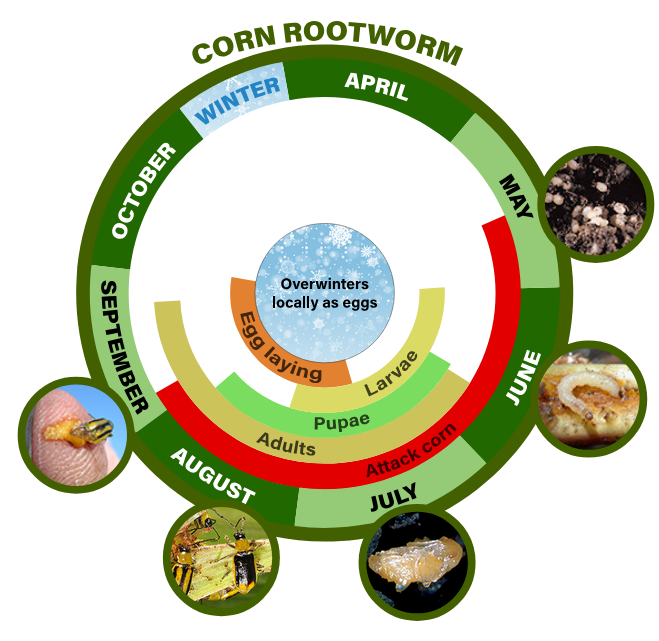
The ability to see these full-sized life-cycle images is currently disabled to resolve an issue.
Related Video Resources:
Appearance and Life History

Photo by J. Obermeyer
Corn rootworms are important insect pest of corn in the Midwest. Two species of rootworms that may cause severe damage to corn as both larvae and adults, are the western and northern corn rootworms. Their damage is typically more likely in continuous corn.
Both sexes of western corn rootworm adults are yellow to yellowish-green in color with a black stripe along the sides of their wing covers and are about 5/16 inch (7.5 mm) long. Male wing covers are often nearly entirely black or at least darker in pigmentation than that of the female, which usually appears as more regular stripes. Slight variations in these color patterns may occur. Female western corn rootworm adults have larger abdomens than the males.
The adult of the northern corn rootworm is a tan to pale green beetle about 1/4 inch (6 mm) long. Newly emerged beetles are usually cream or light brown in color, but gradually turn green. No marked differences in coloration exist between sexes, but female beetles are typically larger than the males.

Photo by J. Obermeyer
The adult of the southern corn rootworm, also known as the spotted cucumber beetle, is about 3/8 inch (9 mm) long, yellow to green in color, with 11 conspicuous black spots on its back. Because adults and larvae of this species are considered of minor economic importance in the Midwest, the following discussion on damage, sampling, and management guidelines will not include the southern corn rootworm.
It is extremely difficult to distinguish between larvae of the western and northern species, and typically not critical for management. Rootworm larvae are white and slender, about 1/2 inch (13 mm) long when fully grown, have brown heads, and a dark plate on the top side of their “tails.”
Western and northern corn rootworm have only one generation per year. Eggs of both species are deposited in the soil by female beetles from mid-summer until autumn. The eggs overwinter and begin hatching from late May to early June in most areas of the Midwest. The newly hatched larvae seek out and feed on corn roots and pass through three stages, or instars, before pupating in the soil.

Photo by J. Obermeyer
By late June to early July, adult beetles begin to emerge from corn fields. The males emerge first, the females following in about 5 to 7 days. Mating takes place a short time thereafter. Within 2 weeks of emergence, females begin to lay eggs, usually toward the end of July, with peak egg laying occurring in early to mid August. The beetles in corn fields feed primarily on pollen, green silks, or leaves.
Rootworm beetles are very mobile and can readily move between fields and may cause damage in locations other than where they emerged. A late maturing corn field can attract large numbers of beetles since neighboring corn may have stopped producing pollen. Beetles may also move into corn and/or soybean fields which have an abundance of pollen-producing weeds, such as volunteer corn, ragweed, or foxtails. Some areas of the eastern Midwest have observed a steady and substantial increase of economic larval damage in first-year corn (corn following another crop). A behavioral variant of the western corn rootworm, that appears to have lost its fidelity for corn, can migrate to neighboring crops such as soybean to feed on pollen, flowers, and foliage, then lay eggs.
Where northern corn rootworm is the dominant species, a trait referred to as “extended diapause” can affect the survivability of the insect. Extended diapause describes a condition whereby a portion of northern corn rootworm eggs are capable of remaining dormant in the soil through two winters and one growing season before hatching in the second season. First-year corn in areas of Minnesota, Iowa, South Dakota, and Wisconsin have been damaged by rootworms exhibiting this extended diapause trait. The western corn rootworm does not show this trait.
Damage
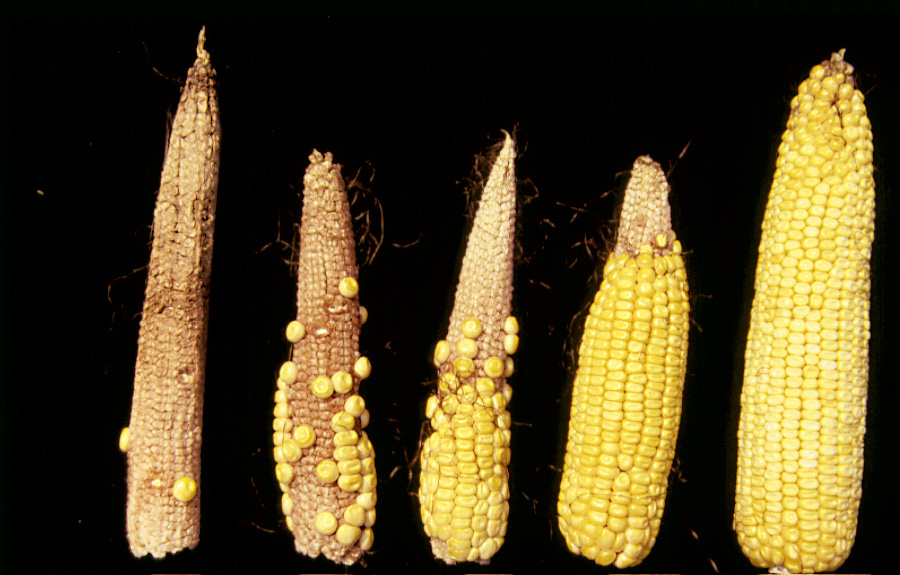
Photo by J. Obermeyer
Both corn rootworm larvae and adults may damage corn plants, although larvae are the key life cycle stage and most likely to require management. Newly hatched larvae feed primarily on root hairs and outer root tissue, whereas older larvae burrow into roots to feed. Primary larval damage is caused by the later instars, typically from mid-June through mid-July. Root tips will appear brown and are often tunneled into and chewed back to the base of the plant.
Larval root pruning reduces water and nutrient uptake of corn plants; this may result in yield reductions, especially in corn also suffering from other stressors. Roots damaged by rootworms may be weakened to the extent that the plants lodge or grow in a curved “sled-runner” or “gooseneck” shape. Lodged and misshapen plants often pollinate poorly and are difficult to harvest, contributing to yield losses. Also, rootworm damage sites are often pathways for infection by pathogens, causing root and/or stalk rots.

Photo by J. Obermeyer
High adult rootworm populations may interfere with corn plant pollination by severely clipping silks during pollen shed. This can result in poorly filled ears.
Western corn rootworm adults may feed on the green tissue of the leaves and partially or totally strip them, resulting in a parchment-like appearance. Typically, only scattered plants are severely damaged. However, such foliar damage can be indicative of a large adult population which may be a serious threat to pollination and next season’s corn roots.
Sampling Method
Larvae in Corn –
- Sampling is only necessary in corn fields with suspected insecticide/Bt hybrid failures or fields where a high adult rootworm population was observed, the previous July-August. Also sample corn fields that were in other crops like soybean the previous season, if beetles were observed or suspected as being present in those crops the previous year.
- 10 areas of a field, 1 randomly chosen plant
- Dig a 7 inch (18 cm) cube of soil around the base of each plant, avoid cutting roots. Lift the plant and soil out of the ground and place them on a small piece of dark canvas or plastic. Break the soil away from the roots and examine the soil and roots for larvae. Wash the soil and root sample in a pail of water to extract the rootworms. The rootworms will float to the top and can be counted. The addition of salt to the water will float the worms to the top more easily.
- Record the number of larvae found on each plant sampled. Determine the average number of rootworm larvae per plant by dividing the total number of larvae found in the field by the number of plants examined. Note whether the numbers were the result of hand sorting or washing the soil and roots.
Adults in Corn –
- Surveys for rootworm beetles should begin shortly before corn silking commences. Sample in the morning or late afternoon.
- If a particular field has been planted to more than one hybrid (not blended together), each hybrid must be scouted separately.
- When silking begins, determine if rootworm adult sampling is necessary by quickly walking across the field. If no beetles are observed in the ear zone area or on the ears, no further scouting will be necessary at this time. Return to the field in 2 to 3 days to again check for beetles. Even if no beetles are found, continue to check a field twice weekly until the silks have been pollinated and then once weekly until early September. If you do see beetles in the field, definite counts, using one of the two following scouting methods, should be made immediately.
- Determining Potential for Silk Damage and Interference with Pollination
- Randomly select and check 5 plants in at least 5 areas (25 total plants) of a field for silk clipping.
- If silk clipping is noted, determine (in inches) what length of the silk remains on each plant sampled. Determine the average silk length per plant by totaling the length for all plants sampled and dividing by 25.
- Record the number of beetles noted for each plant and determine the field average.
- Estimate and record the percent of pollination by unwrapping the husk leaves from an ear and then gently shaking the ear. The silks from fertilized ovules will readily drop off the ear. Note if pollen is being shed by inspecting the tassels of each plant sampled. Remember that weather can greatly affect whether pollen in being shed. Record the results.
Adults in Soybean and Some Other Crops – Two sampling methods, sweeping and sticky traps, can be used in soybean and other non-corn crops to determine the potential for western corn rootworm larval damage to next year’s corn roots. Both methods need to be implemented and carried out from the end of July through the first week in September.
- Sweeping
- Sweeping soybean (refer to page C-78), and other crops like alfalfa, requires the use of a 15 inch (38.1 cm) diameter sweep net.
- Walk the field in a “M” pattern, take 20 continuous sweeps in 5 different areas of a field (keeping the net closed between the 5 areas).
- Take sweeps from areas that represent differences in topography, i.e., high ground, low ground, near waterways, wetter areas, dryer areas, dark soil, light soil, etc.
- Areas of a field within approximately 50 feet (15.2 m) of a corn field(s) should be sampled separately since a natural “spillover” of beetles can often be observed in these areas.
- A sweep consists of one quick movement of a sweep net through the foliage from one side of the body to the other with the top of the net slightly above the top of the foliage. In soybean, the length of the sweep covers an area equivalent to about two 30-inch (76.2 cm) rows. As each sweep is completed, the net is reversed and brought down through the foliage from the opposite direction as one walks at a normal pace.
- Once all 100 sweeps have been taken, either immediately count and record the number of western corn rootworm beetles in the net or place the contents of the net in a plastic bag and freeze until beetle counts can be made.
- Sweep samples should be taken on a weekly basis for 6 weeks.
- Sticky Traps
- Place Pherocon AM® yellow sticky traps on stakes throughout soybean and/or other fields like alfalfa.
- Place a minimum of six traps in different locations of a field and leave for a week before removal and counting. Position traps on stakes or posts so that the traps show just above the crop canopy.
- Each week, for 6 weeks, remove old traps, and install new traps just above the growing crop.
- Count the captured beetles and record the numbers weekly.
Management Guidelines
Corn Insect Control Recommendations: E-series 219-W (PDF)
- For years, crop rotation has been a major management strategy for corn rootworm. As a general rule, rootworms cannot successfully complete their larval development on crops other than corn. Thus, if rootworm eggs are laid in a corn field one season and a soybean field the next season, the young larvae find themselves without a suitable host plant and soon starve to death in the soybean field. However, where the western corn rootworm variant or the northern corn rootworm extended diapause trait exists in the Midwest, crop rotation by itself is no longer an effective management strategy in all regions. Sampling for larvae and adults, as described previously, is imperative to apply the following management guidelines.
Larvae in Corn
- Hand-Sorting of Soil
Two or more rootworm larvae/plant prior to lay-by may signal the need for rootworm larval control. - Washing the Roots and Flotation
Eight or more rootworm larvae/plant prior to lay-by may signal the need for rootworm larval control.
Adults in Corn
- For Prevention of Silk Clipping and Interference with Pollination
- Rootworm Larval Prediction for Next Year’s Corn
For fields returning to corn, predictions based on the current year’s average number of beetles per plant during late July through August.
a) Continuous Corn – Beetle counts in fields planted to corn for two (2) or more years. Next season rotate to another crop or treat for rootworm larvae at cultivation or planting, if the average beetle count per plant equals or exceeds the number listed below for your average number of plants per acre.
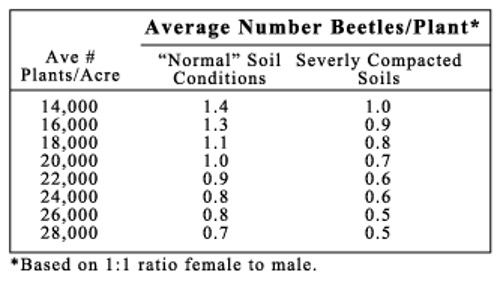
b) First-Year Corn – Beetle counts in first-year corn fields. Next season rotate to another crop or treat for rootworm larvae at cultivation or planting if the average beetle count per plant equals or exceeds the number listed below for your average number of plants per acre.
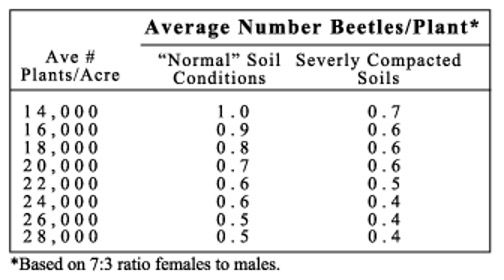
c) Sequential Sampling – This sampling method, modified from the above, is based on sampling only enough beetles to determine the likelihood of an economic larval population developing in next year’s corn, if going back to corn.
- Sample plants by walking the field in a U- shaped pattern.
- If fewer than 3 beetles are found on the first 10 plants, sampling may be terminated until the next week. If 3 to 17 beetles are found on the first 10 plants, continue sampling. More than 17 beetles indicates an economic population is present; stop sampling. If 54 plants have been sampled and counts are still in the intermediate range, stop sampling and return to the field and repeat the sampling procedure in one week.
- Weekly scouting should continue until an economic population is present or until the numbers of beetles decline in late August or early September.
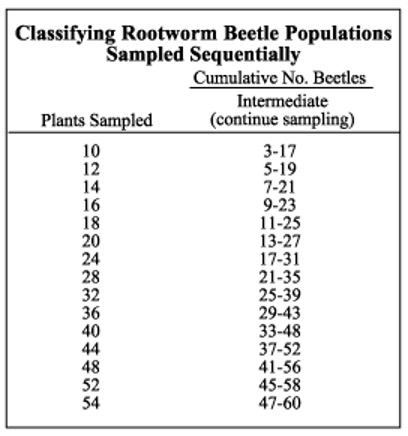
Adults in Soybean and Other Crops – Data is not available for the exact number of western corn rootworm beetles needed in soybean or other crops to cause economic larval damage in corn the following year. Consult with university researchers in the Midwest for new developments on the establishment of an economic threshold(s).

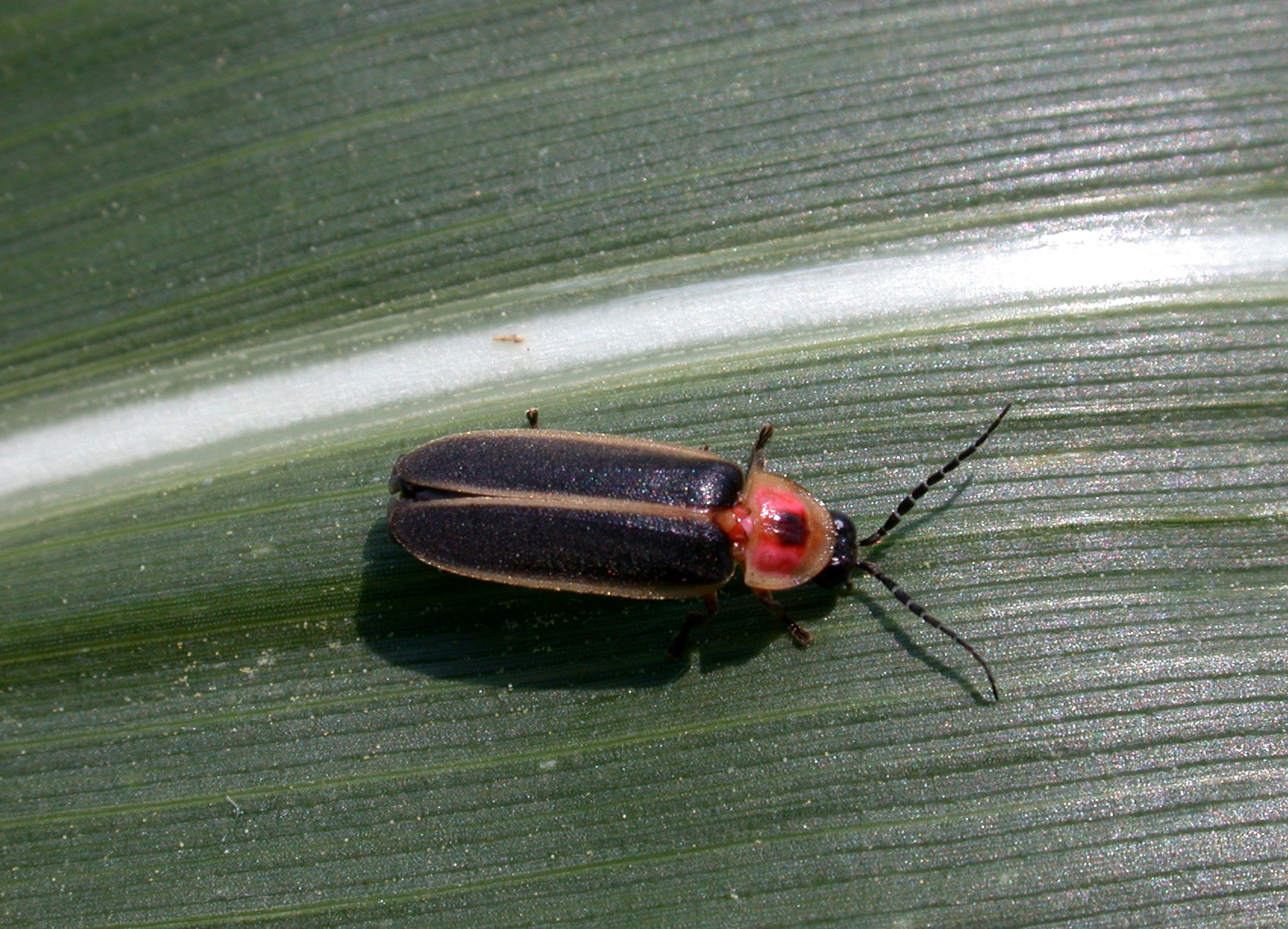
Photo by J. Obermeyer
Nightly flashes of fireflies, seen from mid-May to early-June, may indicate that rootworm hatch is underway.
